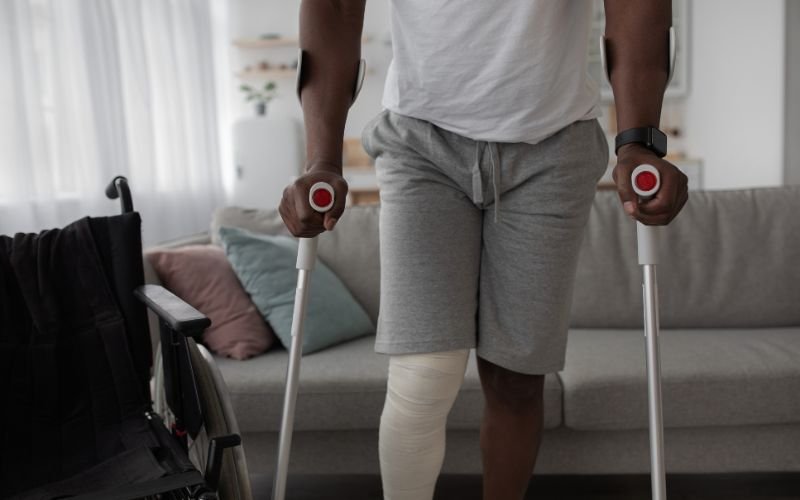The biggest nightmare for any sportsperson is getting injured while playing their favourite sport. Sports injuries are frequent across all sports disciplines and are generally caused by the severe physical demands imposed on players. The fractures can be painful yet but Dr. S Mahanta, one of the top orthopedics doctor in Delhi says that these are fully treatable. Fractures can affect the mobility of the players, affecting their performance in the long run, if severe. Athletes, coaches, trainers, and medical professionals alike need to understand all about fractures in sports injuries.
This blog explains the types of fractures in sports injuries, what causes them, and how to cure them. The Bone Clinic, an orthopedic hospital in Dwarka helps every person live a healthy life by treating their injuries and restoring their mobility.
What are sports injuries?
Sports injuries are injuries that occur during exercise or sports. They can affect anyone, but some factors can increase the risk of injury. Sports injuries are commonly caused by overuse, direct impact, or the application of force that is greater than the body part can structurally withstand. Most people recover and return to normal activities. However, serious sports injuries can require surgery and physical therapy. If the injury doesn’t heal within two weeks, contact your doctor for an appointment.
Sports fractures
Sports fractures are common in athletes and can be caused by repetitive stress, trauma, or overuse. They can occur during competitive or recreational activities and can significantly impact performance.
Fractures are often painful and can cause swelling, bruising, and deformity. The pain usually worsens with movement, and most fractures will swell immediately. More complex fractures may break the skin, making the injury more visible and easier to diagnose.
Types of sports injuries
These are some of the common types of fractures in sports:
Stress fracture
Stress fractures are common in athletes, especially track-and-field athletes, runners, and military recruits. They can occur when the frequency or intensity of physical activity increases suddenly, or when muscles are too tired to absorb the impact of exercise. Stress fractures can also develop from normal use of a weakened bone, such as osteoporosis.
Treatment: Stop the activity that caused the fracture and stay off the affected limb until your doctor says it’s okay to bear weight. Use crutches, a walking boot, a brace, or a cast to reduce stress on the injured bone.
Spiral fracture
Spiral fractures are a type of fracture in which a long bone is twisted in half by an impact or twisting force. Sports injuries, falls, and accidents cause these fractures when bones are twisted with great force, such as during a tackle in football. The mobility in such fractures may be restricted and the affected area may be swelled.
Treatment: Though the treatment depends upon the severity of the fracture, surgery may be required in most cases with general anaesthesia.
Compression fracture
A compression fracture occurs when there is a small crack in the vertebrae caused mainly by trauma or osteoporosis. In athletes, these fractures occur when a strong push pulls the vertebrae together causing them to collapse. These fractures are common in the spine or torsos.
Treatment: Stable compression fractures can heal without surgery if treated with a thoracolumbar spinal orthosis brace and activity restrictions. Athletes can return to activity within a few months.
Oblique fracture
An oblique fracture occurs when there is a break in the bone that occurs diagonally in the bone. They are often caused by twisting injuries, such as landing on a bone at an angle after a fall or being hit from an angle, like in a car accident or tackle during a football game.
Treatment: Braces to support the bone, Traction, Surgically inserted metal rods or plates to hold the bone pieces together, and Pain relief.
Segmental fracture
A segmental fracture is a broken bone that occurs when a bone breaks in two or more places, separating a segment of the bone. Segmental fractures are usually caused by serious traumas, such as car accidents or falls from high places, and can affect any long bone in the body.
Treatment: They are serious injuries. Some of the treatments are Non-operative management. Intramedullary nailing. Plating. External fixation. Plate osteosynthesis. Interlock nailing and plate and cable hybrid technique.
Orthopedician in Dwarka, Delhi
As we mentioned, fractures in sports injuries are treatable. You must visit the best orthopaedic in dwarka, delhi before taking self-medications. Most persons who break a bone fully recover and may resume their pre-injury routines and activities with no long-term consequences.
Do not hasten your recovery. Giving your body the time it needs to heal might be irritating, but it’s the greatest approach to avoid re-injuring your bone as it recovers. We hope this guide helped you, and you can identify various types of fractures in sports injuries and know their treatments to live a healthy life and start playing your favourite sport again.




